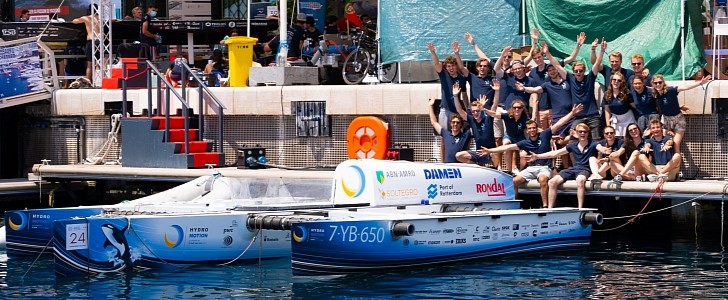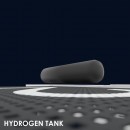After building fast, solar-powered boats every year, for a project that was initiated 15 years ago, a team of engineering students at the Delft University of Technology in Netherlands is developing the world’s first hydrogen-powered flying boat, which will be racing next year.
In 2005, a team of Maritime Engineering students created the TU Delft Solar Boat Team, which would design and built a new boat every two years, and later on - every year. Every new team would optimize what was done before, and bring innovations to increase the performance of these boats that are powered by clean energy and that “fly” on water, thanks to the hydrofoils that lift them.
This year’s team is doing something completely new, by switching from solar power to hydrogen. Called Hydro Motion, this project intends to demonstrate that hydrogen fuel cell is a viable alternative for powering boats. A previous trimaran from 2019 was redesigned, replacing the solar deck with two nets for safety, a hydrogen system, and a cap on top to protect the tank. The hulls and the cap are made out of reinforced carbon fiber, which is light and sturdy enough to withstand any conditions on the Mediterranean.
The 7.5-foot-long (2.3 meters) tank weighs more than 264 lbs (120 kg) on its own, which is heavier than the project’s 2020 entire boat, and it can store 7.6 lbs (8 kg) of gaseous hydrogen at 350 bar. A 70 HP three-phase electric brushless motor propels the ship, enabling it to reach almost 25 mph (40 kph). In addition, the team designed the vessel with hydrofoils to reduce drag, making the trimaran lift nearly 16” (40 cm) above the water when it reaches its take-off speed.
A height control system with three sensors was added for stability – the sensors measure the boat’s height and orientation constantly and control the foils accordingly. Other necessary additions were a DCDC converter (because of the voltage difference between the motor and the fuel cell), plus a cooling system (because of the voltage difference between the motor and the fuel cell), plus a cooling system (the fuel cell alone generates more heat than the previous year’s boat).
This pioneering flying hydrogen-powered trimaran was unveiled recently at the Offshore Energy Exhibition & Conference (OEEC) 2021, and next year’s Solar Boat Team will race it at the Monaco Energy Boat Challenge.
This year’s team is doing something completely new, by switching from solar power to hydrogen. Called Hydro Motion, this project intends to demonstrate that hydrogen fuel cell is a viable alternative for powering boats. A previous trimaran from 2019 was redesigned, replacing the solar deck with two nets for safety, a hydrogen system, and a cap on top to protect the tank. The hulls and the cap are made out of reinforced carbon fiber, which is light and sturdy enough to withstand any conditions on the Mediterranean.
The 7.5-foot-long (2.3 meters) tank weighs more than 264 lbs (120 kg) on its own, which is heavier than the project’s 2020 entire boat, and it can store 7.6 lbs (8 kg) of gaseous hydrogen at 350 bar. A 70 HP three-phase electric brushless motor propels the ship, enabling it to reach almost 25 mph (40 kph). In addition, the team designed the vessel with hydrofoils to reduce drag, making the trimaran lift nearly 16” (40 cm) above the water when it reaches its take-off speed.
A height control system with three sensors was added for stability – the sensors measure the boat’s height and orientation constantly and control the foils accordingly. Other necessary additions were a DCDC converter (because of the voltage difference between the motor and the fuel cell), plus a cooling system (because of the voltage difference between the motor and the fuel cell), plus a cooling system (the fuel cell alone generates more heat than the previous year’s boat).
This pioneering flying hydrogen-powered trimaran was unveiled recently at the Offshore Energy Exhibition & Conference (OEEC) 2021, and next year’s Solar Boat Team will race it at the Monaco Energy Boat Challenge.








